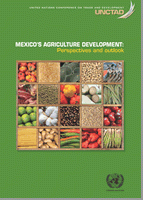
Mexico’s Agricultural Development: Perspectives and Outlook (Outlook) is the response by UNCTAD to a request made by SAGARPA to address the issue of Mexican agricultural development and policy with an integrated, holistic approach.
The Outlook addresses key issues affecting agricultural production and trade of those commodities identified by the Mexican authorities as being of strategic importance for the country. It encompasses both macroeconomic and microeconomic issues with links to commodities, trade policy and trade agreements, competition and competitiveness, and food and energy security.
It also identifies complementary measures and enabling policies, such as infrastructural investment, research and development, and trade facilitation. Furthermore, the Outlook demonstrates close integration with the national development outlook of Mexico, which ensures ongoing consistency with overall national development priorities, including enhancing food security, and reducing poverty, consistent with United Nations Millennium Development Goal 1.
Extensive primary research has been carried out to facilitate this diagnosis, including data collection, numerous videoconferences and interviews with many stakeholders within Mexico’s agricultural sector, including various Mexican government agencies. This component was coordinated by the SAGARPA and the Permanent Mission of Mexico in Geneva.
Agriculture remains a very important sector for Mexico. Despite the declining contribution of the sector to GDP, and the shrinking of agricultural labour force, about half of the rural population was employed in the sector in 2011. Poverty in rural areas in Mexico is high and has been increasing. In 2008, 61 per cent of the rural population (with an average annual income of 3,800 pesos) was classified as poor, as compared to a national rate of 45 per cent.
In 2007, small farms represented approximately 73 per cent of total production units. Indeed, small and medium producers employ a majority of the rural population but their potential to provide a decent livelihood for themselves and to constitute a viable base for expanding economic activity in rural areas is curtailed by a variety of constraints. These include rising costs of factor inputs, land possession issues, adverse climatic conditions, increasing competition from below-cost imports, structural rigidities and some public policies, which although designed to benefit small and medium holders have not had the intended impact.
There is the need for public policy and private action (possibly public–private partnerships) to address the root causes of the continued economic marginalization of small holders, and of agriculture generally, in order to enhance the sector’s resilience and ensure food security.
It is in this context that this diagnosis was undertaken not only to provide extensive analysis and a comprehensive discussion of the agricultural sector in Mexico but also to identify realistic policy recommendations that provide workable solutions to enhancing the development impact of the agricultural sector. It is important, however, that agricultural development is regarded as an opportunity within the Mexican economy to be exploited to create jobs, reduce poverty and enhance food security, rather than a problem; and that SAGARPA can, and indeed must, be an integral part of the rejuvenation and the sustainable development process of Mexican agriculture.


